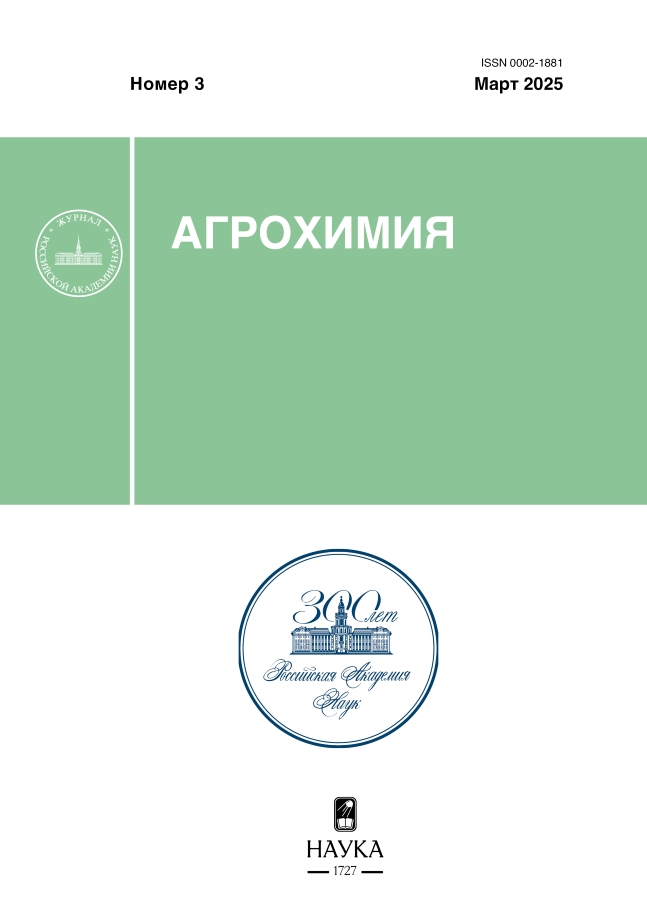Methods for Optimizing Fertilizer Doses on Gray Forest Soils of the Vladimir Opole
- Authors: Okorkov V.V.1
-
Affiliations:
- Verkhnevolzhsky Federal Agrarian Scientific Center
- Issue: No 3 (2025)
- Pages: 20-31
- Section: Experimental Articles
- URL: https://ruspoj.com/0002-1881/article/view/682825
- DOI: https://doi.org/10.31857/S0002188125030032
- EDN: https://elibrary.ru/UQTKJT
- ID: 682825
Cite item
Abstract
The influence of mineral and organomineral (NPK + cattle manure) fertilizer systems in crop rotation on the yield of grain crops and annual grasses has been studied in a long-term stationary experiment on gray forest soils of the Vladimir Opole. It was found that it was 84.3–98.5% dependent on N-NO3 reserves formed during the growing season of crops. These reserves, with the combined use of cattle manure up to 80 t/ha for rotation of crop rotation and one-time N80 as part of NPK for culture, did not limit its yield. It is proposed to predict the yield of grain and hay of cultivated crops based on the relationship of the nitrogen mobilization pool with N-NO3 reserves formed during the growing season of spring crops and from regrowth to harvesting of winter crops, and their utilization coefficients for nitrogen removal by grain and straw. The size of the formation of N-NO3 reserves during the growing season and the coefficients of their use for takeaway products are estimated by zonal research institutions; the mobilization pool of nitrogen is calculated from the adopted fertilizer system. Data on nitrogen removal from products can be used from reference literature, more correctly from research data from research institutions. For grain crops and annual grasses of the 7-field crop rotation, a good agreement of the experimental yield with the calculated one was obtained. It has been reliably established that with an increase in the aridity of the growing seasons during the cultivation of spring cereals and annual grasses, the role of the nitrogen mobilization pool in the transformation of soil nitrogen into its mobile forms increases. It is shown that on gray forest soils of the Upper Volga region, when using organomineral fertilizer systems in a 7-field crop rotation, a single dose of N40P40K40 is optimal for the cultivation of grain crops, N60–75 – for the cultivation of annual legume-cereal grasses.
Full Text
About the authors
V. V. Okorkov
Verkhnevolzhsky Federal Agrarian Scientific Center
Author for correspondence.
Email: okorkovvv@yandex.ru
Russian Federation, 3, Tsentralnaya St., Novy Village, Suzdal District, Vladimir Region, 601261
References
- Окорков В.В., Григорьев А.А., Аркадьева М.Ф. Влияние систем удобрения на продуктивность севооборота и плодородие серой лесной почвы Владимирского ополья // Агрохимия. 1997. № 5. С. 55–65.
- Окорков В.В. Удобрения и плодородие серых лесных почв Владимирского ополья. Владимир: ВООО ВОИ, 2006. 356 с.
- Окорков В.В., Фенова О.А., Окоркова Л.А. Приемы комплексного использования средств химизации в севообороте на серых лесных почвах Верхневолжья в агротехнологиях различной интенсивности. Суздаль: Владимирский НИИСХ, 2017. 176 с.
- Окорков В.В., Фенова О.А., Окоркова Л.А. Серые лесные почвы Владимирского ополья и эффективность использования их ресурсного потенциала. Иваново: ПресСто, 2021. 188 с.
- Окорков В.В., Окоркова Л.А., Коновалова Л.К. Серые лесные почвы Владимирского ополья, их формирование и оценка ресурсного потенциала: удобрение и питание полевых культур. Суздаль–Воронеж: Минобрнауки РФ, Верхневолжский ФАНЦ, 2023. 241 с.
- Окорков В.В. Модели продуктивности зернового севооборота на серых лесных почвах Верхневолжья // Рос. сел.-хоз. наука. 2018. № 1. С. 30–34.
- Окорков В.В. Удобрение и питание полевых культур азотом на серых лесных почвах Верхневолжья // Агрохимическая наука – синтез академических знаний и практического опыта: Мат-лы Всерос. конф., МГУ им. М.В. Ломоносова. М.: Постер-М, 2023. С. 125–126.
- Окорков В.В., Окоркова Л.А., Лебедева А.Е. Питание однолетних трав азотом на серых лесных поч-вах Владимирского ополья // Владимир. земледелец. 2024. № 1(107). С. 31–38.
- Щукин И.М., Окорков В.В., Окоркова Л.А., Лебедева А.Е., Щукина В.И. Влияние удобрений и погодных условий на урожайность ячменя и содержание подвижных форм азота на серых лесных почвах Ополья // Владимир. земледелец. 2024. № 1(107). С. 47–56.
- Практикум по агрохимии / Под ред. Б.А. Ягодина. М.: Агропромиздат, 1987. 512 с.
- Системы земледелия / Под ред. А.Ф. Сафонова. М.: КолосС, 2009. 447 с.
- Научные основы систем земледелия Владимирской области / Под ред. Бирюкова И.В., Зинченко С.И. Владимир: ВООО ВОИ ПУ “Рост”, 2009. 308 с.
Supplementary files










